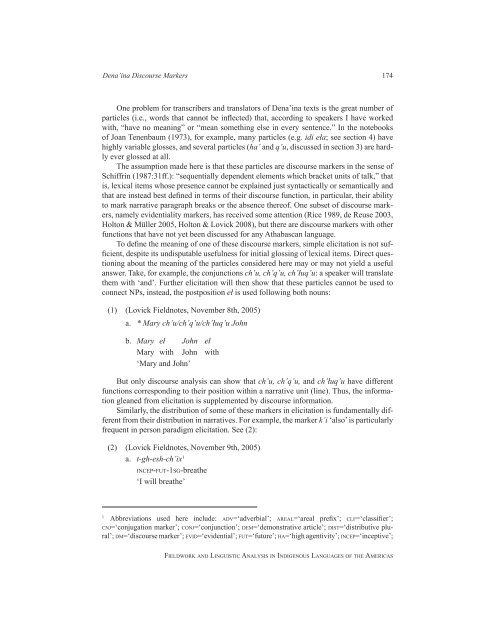Fieldwork and Linguistic Analysis in Indigenous ... - ScholarSpace
Fieldwork and Linguistic Analysis in Indigenous ... - ScholarSpace
Fieldwork and Linguistic Analysis in Indigenous ... - ScholarSpace
You also want an ePaper? Increase the reach of your titles
YUMPU automatically turns print PDFs into web optimized ePapers that Google loves.
Dena’<strong>in</strong>a Discourse Markers 174<br />
One problem for transcribers <strong>and</strong> translators of Dena’<strong>in</strong>a texts is the great number of<br />
particles (i.e., words that cannot be <strong>in</strong>flected) that, accord<strong>in</strong>g to speakers I have worked<br />
with, “have no mean<strong>in</strong>g” or “mean someth<strong>in</strong>g else <strong>in</strong> every sentence.” In the notebooks<br />
of Joan Tenenbaum (1973), for example, many particles (e.g. idi eła; see section 4) have<br />
highly variable glosses, <strong>and</strong> several particles (ha’ <strong>and</strong> q’u, discussed <strong>in</strong> section 3) are hardly<br />
ever glossed at all.<br />
The assumption made here is that these particles are discourse markers <strong>in</strong> the sense of<br />
Schiffr<strong>in</strong> (1987:31ff.): “sequentially dependent elements which bracket units of talk,” that<br />
is, lexical items whose presence cannot be expla<strong>in</strong>ed just syntactically or semantically <strong>and</strong><br />
that are <strong>in</strong>stead best def<strong>in</strong>ed <strong>in</strong> terms of their discourse function, <strong>in</strong> particular, their ability<br />
to mark narrative paragraph breaks or the absence thereof. One subset of discourse markers,<br />
namely evidentiality markers, has received some attention (Rice 1989, de Reuse 2003,<br />
Holton & Müller 2005, Holton & Lovick 2008), but there are discourse markers with other<br />
functions that have not yet been discussed for any Athabascan language.<br />
To def<strong>in</strong>e the mean<strong>in</strong>g of one of these discourse markers, simple elicitation is not sufficient,<br />
despite its undisputable usefulness for <strong>in</strong>itial gloss<strong>in</strong>g of lexical items. Direct question<strong>in</strong>g<br />
about the mean<strong>in</strong>g of the particles considered here may or may not yield a useful<br />
answer. Take, for example, the conjunctions ch’u, ch’q’u, ch’łuq’u: a speaker will translate<br />
them with ‘<strong>and</strong>’. Further elicitation will then show that these particles cannot be used to<br />
connect NPs, <strong>in</strong>stead, the postposition eł is used follow<strong>in</strong>g both nouns:<br />
(1) (Lovick Fieldnotes, November 8th, 2005)<br />
a. * Mary ch’u/ch’q’u/ch’łuq’u John<br />
b. Mary eł John eł<br />
Mary with John with<br />
‘Mary <strong>and</strong> John’<br />
But only discourse analysis can show that ch’u, ch’q’u, <strong>and</strong> ch’łuq’u have different<br />
functions correspond<strong>in</strong>g to their position with<strong>in</strong> a narrative unit (l<strong>in</strong>e). Thus, the <strong>in</strong>formation<br />
gleaned from elicitation is supplemented by discourse <strong>in</strong>formation.<br />
Similarly, the distribution of some of these markers <strong>in</strong> elicitation is fundamentally different<br />
from their distribution <strong>in</strong> narratives. For example, the marker k’i ‘also’ is particularly<br />
frequent <strong>in</strong> person paradigm elicitation. See (2):<br />
(2) (Lovick Fieldnotes, November 9th, 2005)<br />
a. t-gh-esh-ch’ix 1<br />
<strong>in</strong>ceP-fut-1sg-breathe<br />
‘I will breathe’<br />
1 Abbreviations used here <strong>in</strong>clude: adv=‘adverbial’; areal=‘areal prefix’; clf=‘classifier’;<br />
cnJ=‘conjugation marker’; conJ=‘conjunction’; dem=‘demonstrative article’; dist=‘distributive plural’;<br />
dm=‘discourse marker’; evid=‘evidential’; fut=‘future’; ha=‘high agentivity’; <strong>in</strong>ceP=‘<strong>in</strong>ceptive’;<br />
fieldwork <strong>and</strong> l<strong>in</strong>guistic analysis <strong>in</strong> <strong>in</strong>digenous languages of the americas

















